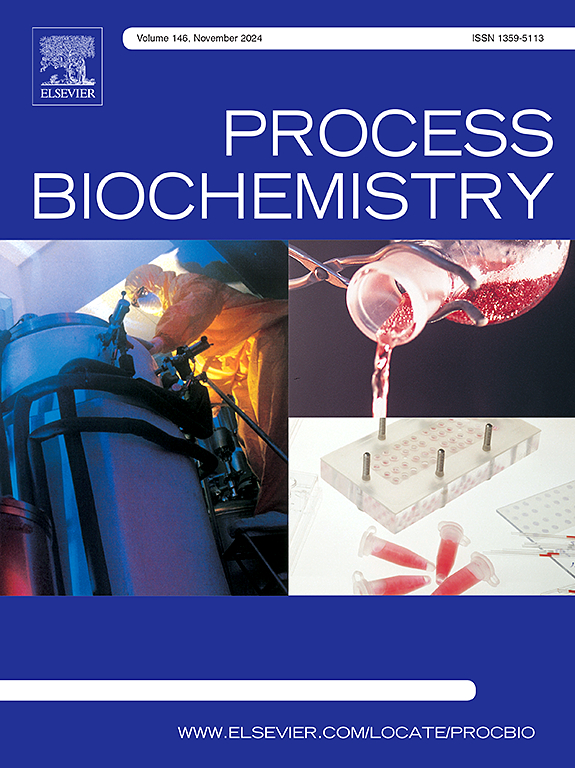Cofactor immobilization for efficient dehydrogenase driven upgrading of xylose
IF 3.7
3区 生物学
Q2 BIOCHEMISTRY & MOLECULAR BIOLOGY
引用次数: 0
Abstract
In this study, the coupled immobilization on nanosilica of xylose dehydrogenase and alcohol dehydrogenase was accomplished with high efficiency, which was 90 %. Moreover, immobilization of the cofactors oxidized and reduced nicotinamide adenine dinucleotide, i.e., NAD+ and NADH, on silica material was examined and the impact on the effectiveness of the process was determined. The highest efficiency of NAD+ immobilization was found to be 56 %, which was obtained after 24 h of immobilization at 30 °C, pH 7 For NADH, the best immobilization efficiency was 53 % which was achieved after 24 h at 25 °C, pH 7. The KM and Vmax values were determined for various configurations of the biocatalytic systems showing, as expected, that immobilization of the enzymes decreased the catalytic rate (Vmax) and slightly increased the KM, but verifying that the immobilization of the cofactors did not significantly affect the kinetics, but would enable high conversion, and potentially continued enzymatic reaction. The use of the system configuration with co-immobilized enzymes, immobilized NAD+ and immobilized NADH thus allowed for obtaining over 90 % efficiency of xylose conversion in one batch, which was significantly higher than the systems with single free or only one immobilized cofactor. Using UV-Vis measurements, it was confirmed that effective cofactor regeneration occurred in the systems with immobilized components thus allowing for sustained enzyme catalyzed upgrading of xylose to xylonic acid.
辅助因子固定化高效脱氢酶驱动木糖升级
以纳米二氧化硅为载体,实现了木糖脱氢酶和醇脱氢酶的高效偶联固定化,固定化率为90% %。此外,还研究了氧化还原烟酰胺腺嘌呤二核苷酸的辅助因子NAD+和NADH在二氧化硅材料上的固定作用,并确定了对该工艺效果的影响。在30°C, pH 7条件下,固定24 h, NAD+的固定效率最高,为56 %。在25°C, pH 7条件下,固定24 h, NADH的固定效率最高,为53 %。测定了不同构型生物催化体系的KM和Vmax值,结果表明,正如预期的那样,酶的固定化降低了催化速率(Vmax),并略微增加了KM,但验证了辅助因子的固定化对动力学没有显著影响,但可以实现高转化率,并可能继续进行酶促反应。使用共固定化酶、固定化NAD+和固定化NADH的体系配置,一次木糖转化效率可达90% %以上,显著高于单一游离辅助因子或只有一种固定辅助因子的体系。使用UV-Vis测量,证实了有效的辅因子再生发生在固定组分的系统中,从而允许持续的酶催化木糖升级为二甲苯酸。
本文章由计算机程序翻译,如有差异,请以英文原文为准。
求助全文
约1分钟内获得全文
求助全文
来源期刊

Process Biochemistry
生物-工程:化工
CiteScore
8.30
自引率
4.50%
发文量
374
审稿时长
53 days
期刊介绍:
Process Biochemistry is an application-orientated research journal devoted to reporting advances with originality and novelty, in the science and technology of the processes involving bioactive molecules and living organisms. These processes concern the production of useful metabolites or materials, or the removal of toxic compounds using tools and methods of current biology and engineering. Its main areas of interest include novel bioprocesses and enabling technologies (such as nanobiotechnology, tissue engineering, directed evolution, metabolic engineering, systems biology, and synthetic biology) applicable in food (nutraceutical), healthcare (medical, pharmaceutical, cosmetic), energy (biofuels), environmental, and biorefinery industries and their underlying biological and engineering principles.
 求助内容:
求助内容: 应助结果提醒方式:
应助结果提醒方式:


